The 9.7" iPad Pro Review
by Brandon Chester on June 1, 2016 9:00 AM ESTSystem Performance
Like the larger iPad Pro, the 9.7" iPad Pro uses Apple's A9X SoC. Apple is never very forthcoming with details like the clock speed for the CPU, GPU, and amount of DRAM. What we can determine about the SoC is that Apple has maintained the 2.2GHz maximum clock speed from the larger iPad Pro, while reducing clocks on the GPU and dropping to 2GB of LPDDR4 RAM.
The RAM situation on the 9.7" iPad Pro is somewhat surprising for a few different reasons. In their always-excellent teardown, the iFixit crew discovered that the smaller iPad Pro only had one Samsung 2GB LPDDR4 memory chip. This explains how Apple scaled down from 4GB to 2GB - the larger iPad Pro had two chips - but it also means that Apple has changed the amount of memory bandwidth available to the A9X SoC as well.
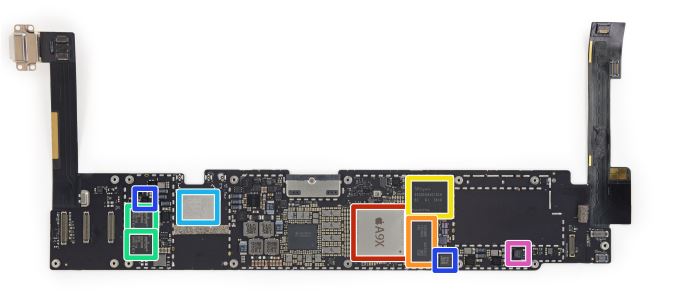
9.7" iPad Pro Logic Board (Image Courtesy iFixit)
To date, all Apple X-series SoCs have shipped with a larger 128-bit memory bus, and until now, Apple always fully populated that bus. So the 9.7" iPad Pro is an outlier in that regard, as this is the first time we've seen an X-series SoC with only the first 64-bit half wired up to a single memory chip in this fashion. In that respect it's a surprising decision from Apple, in part because of the importance of memory bandwidth in feeding the large, powerful GPUs on the X-series SoCs.
Consequently there is going to be more to the 9.7" iPad Pro than just the original Pro in a smaller chassis. The 9.7" iPad Pro should match the larger model in anything that depends heavily on CPU speed or memory bandwidth, while falling behind to some degree in GPU-bound tests. The 12 cluster PowerVR Series7XT GPU inside A9X will be having to make do with less memory bandwidth, though offset to some degree by the lower resolution of the screen.
With the above in mind, I quickly benchmarked the 9.7" iPad Pro on a couple of our memory bandwidth benchmarks. The results are somewhat inconclusive.
| Geekbench 3 Memory Bandwidth Comparison (1 thread) | ||||||
| Stream Copy | Stream Scale | Stream Add | Stream Triad | |||
| 9.7" iPad Pro | 17.1 GB/s | 11.5 GB/s | 12.9 GB/s | 12.8 GB/s | ||
| 12.9" iPad Pro | 20.8 GB/s | 15.0 GB/s | 15.3 GB/s | 15.1 GB/s | ||
I say "inconclusive" because although the 9.7" iPad Pro consistenly scores lower in Geekbench 3's memory bandwidth benchmarks and other memory benchmarks, it's never a 50% drop as we get on paper. In practice these numbers are far from the maximum memory bandwidth A9X is capable of, and I suspect that the CPU paths simply aren't wired in such a fashion that they can fully saturate A9X, especially given the fact that it's the GPU that needs the bandwidth more. So although we see some impact of the narrower memory bus in dedicated memory bandwidth benchmarks, these can't paint a very clear picture. It's going to be our high level GPU performance benchmarks that really give us an idea of the impact of reduced memory bandwidth.
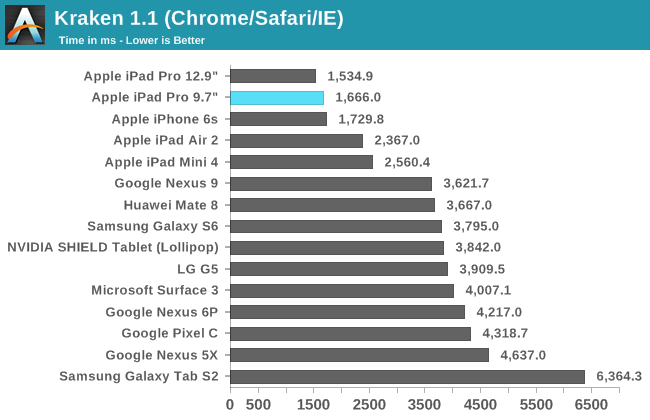
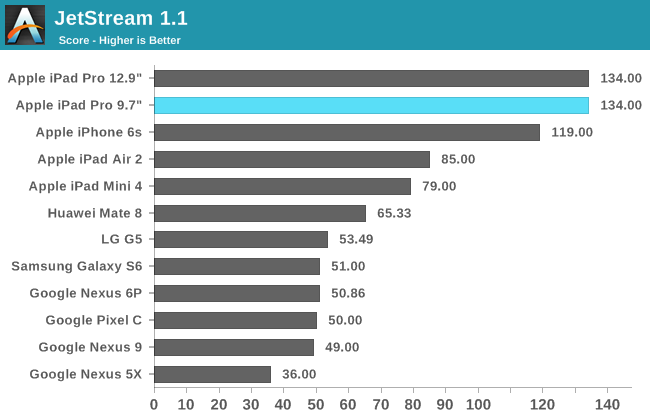
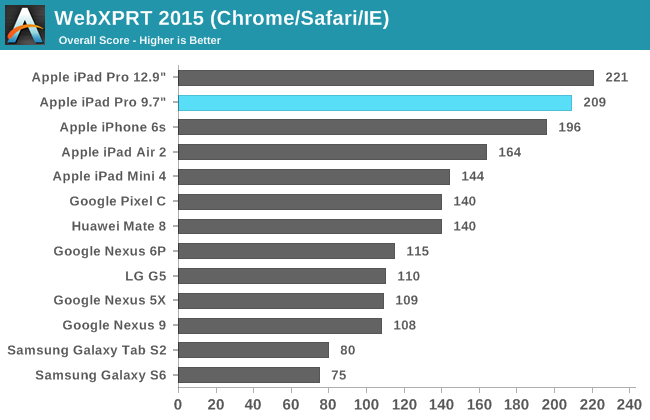
With the 9.7" iPad Pro having the same two 2.2GHz Apple Twister cores as the 12.9" model, it's no surprise to see the two neck and neck in our browser tests. In Jetstream 1.1 the two achieve the exact same score, while in the other two tests the 9.7" model is a bit slower, but with the gap being small enough to attribute to testing variance. With A9X Apple moved back to a dual-core CPU from A8X's tri-core CPU, with the move to TSMC's 16nm FinFET process allowing peak clock speeds to go up by 700MHz. Because JavaScript performance is mostly bound by a device's single threaded performance, A9X came with a significant performance uplift during web browsing. Given that the 12.9" iPad Pro offered the best web browsing performance of a mobile device, bringing that performance to the 9.7" iPad makes for a notable improvement over the performance of the iPad Air 2.
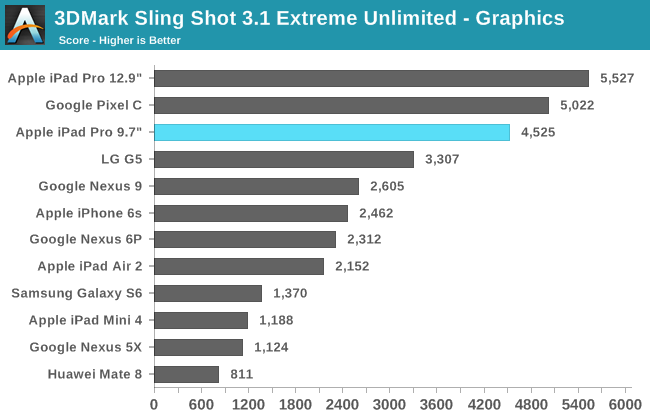
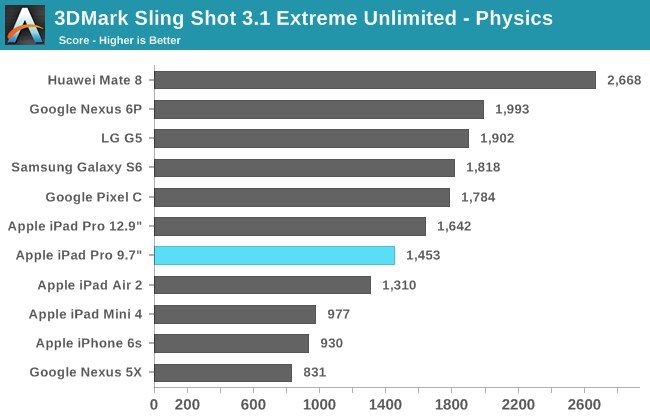

The 9.7" iPad Pro does well in 3DMark's graphics test, but like Ice Storm it doesn't do well in the physics test. It seems that this test is programmed in a similar way to Ice Storm, and in that sense I'm not sure how representative the physics test is of real-world performance because with an actual mobile game you wouldn't use highly random memory access and data structures with heavy memory dependencies when it would perform very poorly on your target devices. In any case, you can see that the 9.7" iPad Pro places third overall, with the 12.9" model at the top of the chart and the Pixel C coming right behind it.
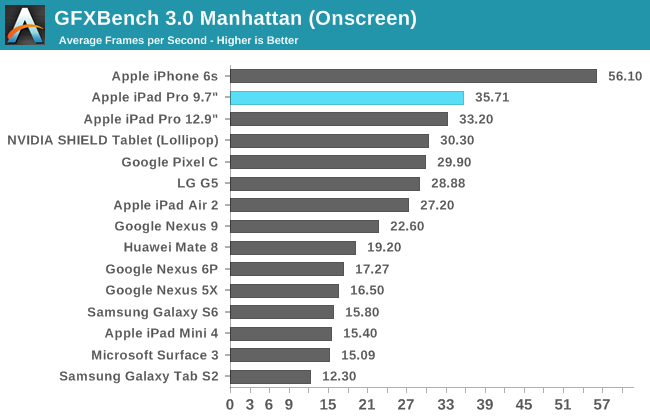
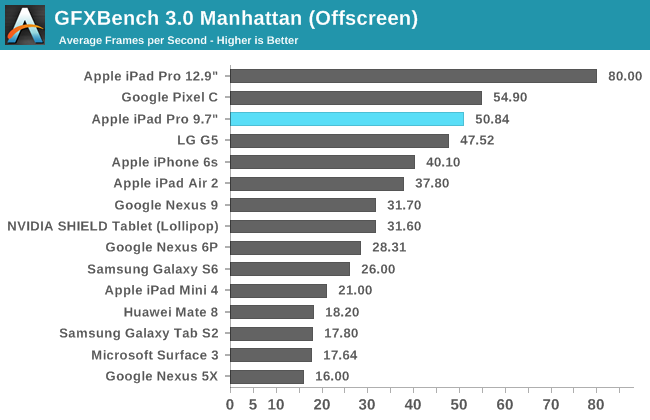
GFXBench 4.0 Car Chase hasn't made its way to iOS yet, and so for now we're still using GFXBench 3.0 Manhattan for iOS devices. Given that the iPhone 6s is the only phone that hits Vsync in this test, it's still a very relevant benchmark in how it represents the level of visual fidelity that a mobile game can currently have on high end devices while still performing well. In the off screen test we can see the impact of the 9.7" iPad Pro's lower clocked GPU combined with the reduced memory bandwidth,, with the smaller iPad performing around 37% lower than that of the 12.9" iPad Pro. The on screen test tells an interesting story though. Both models of the iPad Pro have roughly the same performance at their native resolutions in this test, which could indicate that Apple was targeting the same performance relative to the display resolution when configuring A9X and its memory, in order to manage heat and energy usage in a smaller iPad Pro.
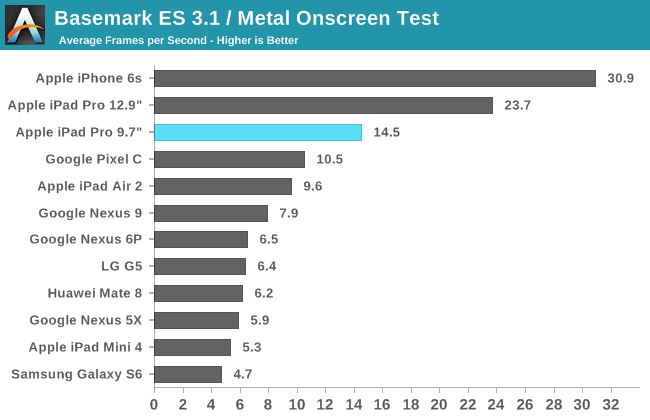
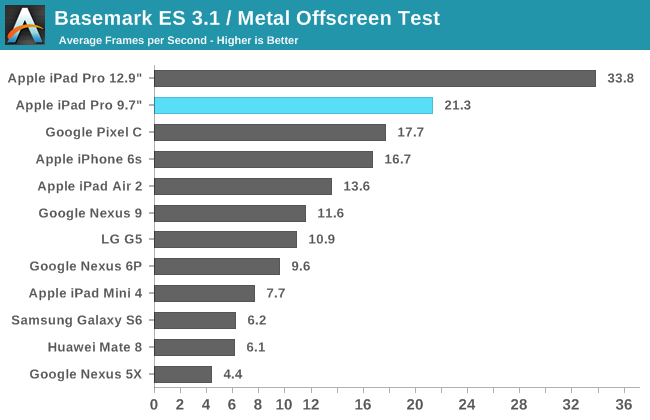
While I didn't have enough data to use BaseMark ES 3.1 at the time of my iPhone SE review, we've since tested enough older devices to deploy it. One could think of this as the successor to BaseMark X, which we retired some time ago before we officially deployed a new mobile test suite for 2016. Once again, both models of the iPad Pro sit above the other tablets on the chart. The iPhone 6s places first in the on screen test due to its relatively low resolution, but without that there the iPads would hold the top two spots in both tests.
NAND Performance
Something that Apple publicized with their A9 and A9X SoCs is improved NAND performance. NAND performance isn't discussed very much in reviews, but it's a very critical aspect of device performance and issues with it tend to cause a device's performance to crash months down the line rather than right off the bat, which makes it something of an invisible problem if you don't look for it during a review. We've seen previously that Apple has been using their own SSD controller in the current generation of iOS devices, and the 9.7" iPad Pro continues this.
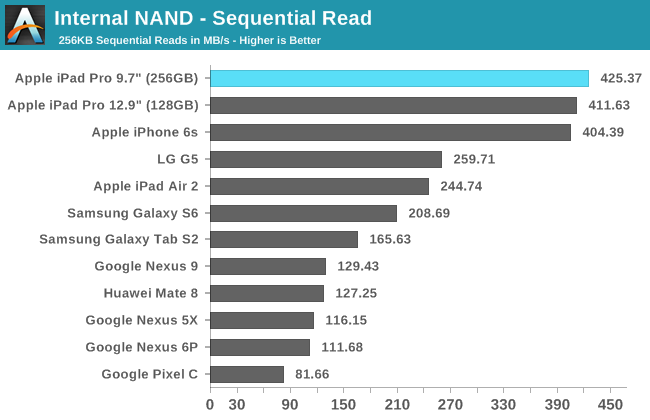
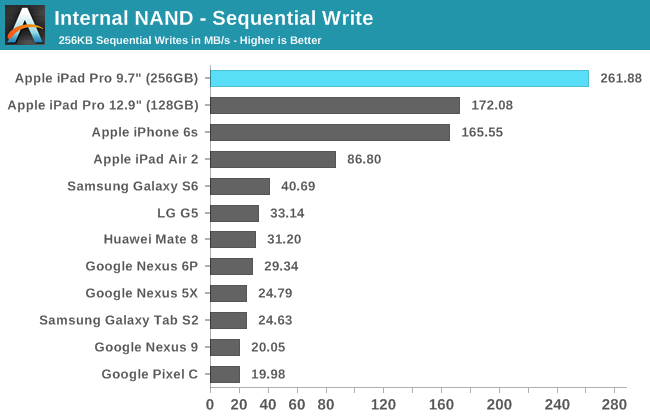
For this review I was sampled the 256GB model of the 9.7" iPad Pro. Because SSDs exploit parallelism heavily to improve performance, a 256GB iPad could improve NAND write performance over the lower-capacity models if it has a greater number of dies. In this case we see that sequential read performance improves a bit, while sequential writes improve dramatically as expected. There's not a lot to say here, as Apple has an enormous lead over the competition in this area.










144 Comments
View All Comments
zeeBomb - Wednesday, June 1, 2016 - link
About time! As a Canadian: to buy or not to buy... That is the question.sachouba - Wednesday, June 1, 2016 - link
It's funny how the iPad Pro 9.7 is compared with the Galaxy S6, the middle range Nexus 5X or the 6 months old Huawei Mate 8 instead of the Galaxy S7, Huawei P9, Xiaomi Mi5 or other 2016 flagships when it comes to performance, display accuracy, recharging time, storage speed, etc.Even with a multicore CPU performance that is not as good as the best CPUs on smartphones right now (the Galaxy S7, for instance), a mediocre contrast (what is the point of having accurate colors if blacks cannot even be rendered properly ?), a price that is way too high, and a battery life that is far from impressive, the iPad Pro is praised in your review...
When it comes to the conclusion, it looks like Apple has invented the "True Tone Display", although it is only a copy of the 2-year-old and not-much-marketed Adapt Display from Samsung – which works great and adapts the white point according to the surrounding environment. You have fallen in Apple's trap of making people believe they invented everything that is known and unknown to Man thanks to aggressive marketing, which is disappointing, to say the least...
Brandon Chester - Wednesday, June 1, 2016 - link
You must have missed the LG G5 in the charts, which is a Snapdragon 820 device. I can't compare to devices that haven't been fully reviewed.Also, you may want to re-read the article to find out why True Tone is not the same as Adapt Display, and to clarify some other things that it seems you missed.
jlabelle2 - Wednesday, June 1, 2016 - link
Quite condescending statement when what you wrote was : "As you move to different environments the color temperature of the display shifts to match how your eye adjusts its perception of white depending on the temperature and brightness of the light around you."Which is exactly what Sachouba describe about Samsung Adapt Display...
jlabelle2 - Wednesday, June 1, 2016 - link
Since departure of Anand, Apple product reviews look like PR marketing speech, although the tests and content itself of the review do not match the speech :- "It’s not hard to conclude that the display on the 9.7” iPad Pro is the best display on any tablet" : except that the Surface (Pro 4) has be shown as having a better display (proven also by Displamate) and the Surface 3 is also shown to have a better display or at least as good with the huge avantage for someone really after color accuracy that they can be calibrated.
- "However, the significant hardware upgrades that Apple has made with this new iPad Pro are enough to make up the difference. the 9.7” iPad Pro is only $50 more than the 128GB iPad Air 2 used to cost" : an argument that makes no sense. EVERYTIME the year passes and a new phone or tablet is released, we used to have more power or a better camera or better performance ... for the SAME price. Otherwise, what is the point of the new model ? Except that here, it is more expensive than the previous model. And it is between 100 to 200$ more expensive than the iPad Air 2. And if you want really to take advantage of the real benefit of the Pro (the keyboard and / or the pencil), you need to spend 100 to 270$ !?! Just insane.
- "As far as performance goes, A9X is still the fastest chip that you’ll find in an ARM tablet" : why restricting tablet to ARM processor ? What does it change for the end user if a tablet is running an ARM chip or a x86 chip ? Especially when even a fanless core M smokes the A9X ? And this is good to make the apology of the power of the "small" iPad Pro but what application is taking advantage of this power versus the iPad Air 2 ? Especially with the 2Go of RAM only ?
- "In the end, the 9.7” iPad Pro is clearly the best standard-sized tablet on the market." : and here it is. How can it be objectively labelled like this ? It seems an excellent tablet but making this universal statement when it is the most expensive, it has not the best display (when it really counts for some), it does not have the best keyboard implementation, it is limited by its RAM, and the biggest asset is also its biggest issue of course as it suffers from limited external peripheric support and of some powerful application / program that people who want a powerful tablet with a good display usually are after (photo / video editing, graphist...). So the hardware strengths are constrained by the software capabilities.
Strange wordings and conclusions regarding a overall very nice tablet but with its share of drawback for its intended audience.
Lochheart - Wednesday, June 1, 2016 - link
Do you know any 10" Tablet with Core M ?digiguy - Wednesday, June 1, 2016 - link
Have a look: http://www.onda-tablet.com/onda-v919-3g-core-m-tab...kmmatney - Thursday, June 2, 2016 - link
I would not recommend an Onda tablet - I bought one myself and it was a bit of a nightmare. There is very little support. A windows update reversed my touchscreen and was a pain to fix. The glass on the screen cracked with very minimal pressure, and finally one-third of the touchscreen simply stopped responding to touch. This was all within 4 months. I finally just sold mine on ebay, with a cracked screen, and telling the buyer that it could only be used with a mouse and keyboard. At least mine was a lot cheaper than the one you linked to, but cannot recommend an Onda tablet...digiguy - Thursday, June 2, 2016 - link
I am not recommending either, just showing that it's feasibleLochheart - Friday, June 3, 2016 - link
Feasible... but does it works ? Throttling, Heat, 1h battery life...And... Windows !